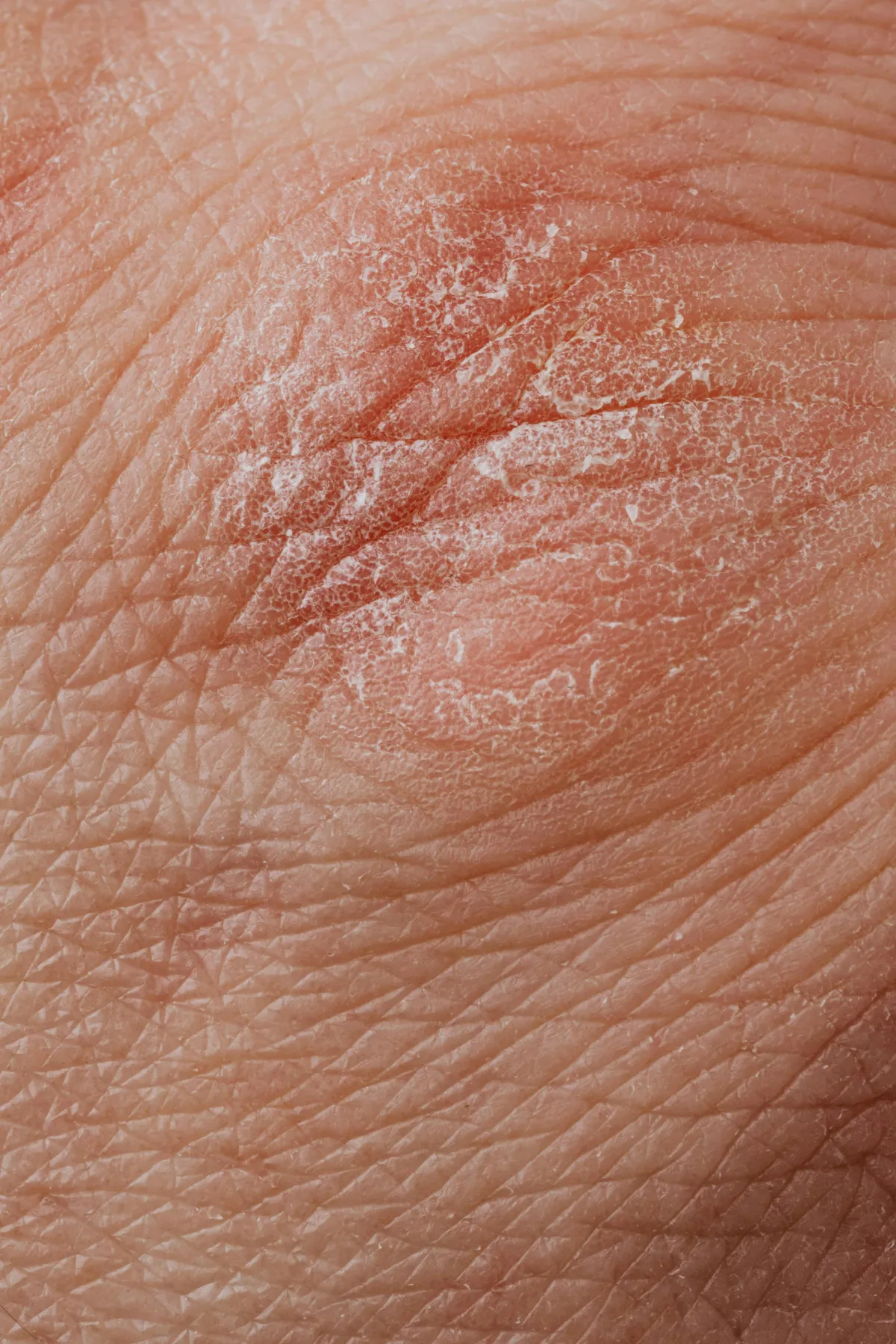St. Pete Location
Bradenton Location
Patient Education
We're passionate about helping people achieve their healthiest, happiest skin. Whether you're struggling with acne, eczema, rosacea, or any other skin concern, we're here to offer support, information, and inspiration.

Skin Deep: Understanding Common Skin Conditions and Diseases (Part 2) | Leah Michel APRN, FNP-BC
Skin Deep: Understanding Common Skin Conditions and Diseases (Part 2)
In dermatology, numerous skin conditions and disorders can impact people of all ages. Being able to identify and understand these issues is essential for prompt diagnosis and proper treatment. This in-depth guide explores a range of skin problems, providing valuable information about their causes, symptoms, and available treatment methods.
Common Skin Conditions and Diseases
Benign Skin Growths
1. Cherry Angiomas
Cherry Angiomas are mall, red, benign growths on the skin (Gonzalez et al., 2021). These lesions consist of clusters of blood vessels and typically appear on the torso, arms, and legs. While they are harmless and usually do not require treatment, they can be removed for cosmetic reasons or if they frequently bleed due to injury.
2. Lipoma
Lipoma is a benign fatty tumor under the skin. Lipomas are described as benign fatty tumors that typically develop under the skin and are characterized by their soft, movable nature. These tumors can vary in size, ranging from small pea-sized lumps to larger masses that can be several centimeters in diameter. While lipomas are generally harmless and painless, they can sometimes cause discomfort if they press against nerves or other structures in the body. Recent research indicates that gut microbiota may play a significant role in the development of lipomas (YL et al., 2024).
3. Dermatofibroma
Dermatofibroma is a benign skin growth that typically appears as a firm, raised nodule on the skin. These growths are common and usually harmless, often developing after minor skin injuries such as insect bites or cuts. Although dermatofibromas do not usually require treatment, they may be removed for cosmetic reasons or if they become painful or bothersome. Recent studies emphasize that dermatofibromas are common benign skin tumors, predominantly occurring on the extremities, with most lesions measuring less than or equal to 2 cm in diameter (Scientific Research Publishing, 2024)
4. Moles (Nevi)
Moles are common benign skin growths. Recent studies suggest that while most moles remain benign, genetic mutations such as those in the BRAF gene can occasionally lead to their progression into melanoma (PubMed Central, 2023). The 'ugly duckling' method, which identifies moles that appear different from others on the same individual, has proven effective for early detection of atypical nevi (PubMed Central, 2023). Statistical analysis has shown that atypical moles are a significant risk factor for melanoma development in certain populations (MDPI, 2025).
5. Skin Tags
Skin tags are small, fleshy growths on the skin that can be removed using radiocautery, which is the most performed procedure. This method involves the passage of high-frequency radio waves through the skin tag to remove it. A novel device applying pressure to the base of skin tags has shown promising results, leading to removal within a few days (eScholarship, 2023). Skin tags, also known as acrochordons, are benign tumors that can be effectively treated through various methods including surgical excision and cryotherapy (Medical News Today, 2024). Recent studies have indicated a significant association between the presence of skin tags and metabolic syndrome, particularly in obese individuals (Wiley Online Library, 2024).
6. Warts
Warts are benign growths caused by the human papillomavirus (HPV). While many warts resolve on their own, understanding treatment options is essential for those seeking quicker removal (National Center for Biotechnology Information, 2023).
Warts are benign growths caused by the human papillomavirus (HPV). While many warts resolve on their own, understanding treatment options is essential for those seeking quicker removal. Recent guidelines highlight that cryotherapy and intralesional bleomycin are among the most effective treatments for warts, with cryotherapy being widely used for its accessibility and efficacy (PubMed Central, 2022).
Autoimmune Skin Conditions
1. Bullous Pemphigoid
Bullous pemphigoid (BP) is a rare, autoimmune skin condition that causes large, fluid-filled blisters to develop on the skin. In BP, the immune system produces antibodies that attack proteins in the layer that connects the outer layer of skin (epidermis) to the next layer (dermis), triggering inflammation and leading to the formation of large, tense blisters. Diagnosis involves a skin biopsy for immunofluorescence testing to detect the autoantibodies, and treatment depends on severity but typically involves topical or systemic immunosuppressive medications like corticosteroids to help heal blisters and reduce itching (Karakioulaki et al., 2024).
2. Dermatomyositis
Dermatomyositis is an inflammatory disease affecting the skin and muscles. Dermatomyositis is a rare autoimmune inflammatory condition affecting both skin and muscles, with high-dose corticosteroids being the first-line treatment (Sontheimer, 2020).
3. Pemphigus
Pemphigus is a serious autoimmune blistering disorder characterized by antibodies targeting desmogleins, essential for skin cell adhesion.
• Pemphigus Vulgaris
Pemphigus vulgaris is a chronic autoimmune disorder that not only affects the physical health of patients but also carries social stigma. This life-threatening condition leads to intra-dermal lesions on the skin and oral mucosa, making swallowing and speaking difficult. Pemphigus vulgaris presents a particular challenge for patients who also suffer from diabetes, hypertension, and other chronic infections. Newer therapeutic interventions are essential to improve the quality of life for immunocompromised patients. (Ahuja & Guptaa, 2020).
• Pemphigus Foliaceus
Pemphigus foliaceus is a rare autoimmune blistering disorder that affects only the skin, sparing the mucous membranes. It is associated with immunoglobulin G (IgG) antibodies against desmoglein-1 (Dsg1), which is located in the granular layer of the epidermis (Zhang et al., 2024). Recent studies highlight the potential of alternative treatments, such as apremilast, which has been shown to effectively manage mild pemphigus foliaceus without the use of systemic glucocorticosteroids or immunosuppressive agents (Zhang et al., 2024).
4. Scleroderma
Scleroderma is a rare autoimmune disease causing hardening of the skin and connective tissues. Studies have shown that pulmonary involvement, particularly interstitial lung disease (ILD) and pulmonary hypertension (PH), is a major cause of morbidity and mortality in patients with scleroderma (Solomon et al., 2022). Recent research emphasizes the importance of early detection and management of these complications to improve patient outcomes, as ILD affects 50%–80% of scleroderma patients and accounts for approximately 40% of SSc-related deaths (Bautista-Sanchez & Khanna, 2024).
5. Morphea (Localized Scleroderma)
Morphea is a skin condition causing hardened, thickened patches. This autoimmune disorder is characterized by inflammation and fibrosis of the skin, leading to various clinical manifestations that can significantly impact the quality of life. Recent studies show that musculoskeletal complications such as flexion contractures and functional impairment arise in deep morphea lesions, necessitating advanced imaging and systemic therapies for effective management (Abbas et al., 2021).
6. Lichen Planus
Lichen Planus is a skin disorder characterized by itchy, flat-topped, purple bumps. This inflammatory condition can impact the skin, mucous membranes, and nails, often manifesting with distinctive lesions that can be intensely itchy. It is associated with various immunological factors, including dysregulated T-cell-mediated cytotoxicity and cytokine imbalances (Wang et al., 2023).
7. Lichen Sclerosus
Lichen Sclerosus is a skin condition causing hardening and thinning of the skin, often in the genital area. The condition is often underdiagnosed and can lead to significant morbidity, including sexual dysfunction and urinary complications. Recent research by Taylor et al. (2024) identifies associations between specific microbial genera (Actinomyces, Anaerococcus, Ezakiella) in the vaginal and vulvar microbiomes and LS symptom severity in post-menopausal patients.
Understanding Skin Conditions and the Importance of Professional Care
Many skin issues can be successfully managed with the right diagnosis and treatment. If you're dealing with any skin-related concerns, it's important to seek guidance from a qualified dermatologist who can provide accurate assessments and customized care.
Meet Leah Michel: Your Go-To Skin Care Expert
At My Skin St. Pete, we’re proud to introduce Leah Michel—our trusted skin care specialist and aesthetic injector. With a deep passion for dermatology and a wealth of experience, Leah delivers a wide array of cosmetic services designed to improve your skin’s health and appearance.
Leah Michel’s Areas of Expertise
Skin Cancer Screenings: Leah is proficient in identifying signs of skin cancer, promoting early detection and prompt treatment.
Comprehensive Skin Exams: She performs thorough full-body skin evaluations to monitor skin health and catch potential concerns early.
Cosmetic Enhancements: Leah provides various aesthetic treatments, including:
Botox to smooth fine lines and wrinkles
Dermal Fillers to restore lost volume and refine facial contours
Other Aesthetic Procedures tailored to address specific skin concerns
Why Choose Leah Michel?
Personalized Treatment Plans: Leah crafts each treatment based on your unique goals and skin needs.
Advanced Techniques: She continually updates her skills with the latest innovations in dermatology.
Caring and Supportive Environment: Leah is known for her gentle approach and commitment to creating a welcoming, patient-centered experience.
Book Your Visit Today
Discover the expert care of Leah Michel at My Skin St. Pete by booking your appointment today. Our welcoming team is here to help you set up a consultation and support your skincare journey.
Disclaimer:
The information on this website is provided for educational and information purposes only and is not medical advice. Always consult with a licensed medical provider and follow their recommendations regardless of what you read on this website. If you think you are having a medical emergency, dial 911 or go to the nearest emergency room. Links to other third-party websites are provided for your convenience only. If you decide to access any of the third-party websites, you do so entirely at your own risk and subject to the terms of use for those websites. Neither My Skin by Leah Michel, APRN, FNP-BC, nor any contributor to this website, makes any representation, express or implied, regarding the information provided on this website or any information you may access on a third-party website using a link. Use of this website does not establish a doctor-patient relationship. If you would like to request an appointment with a health care provider, please call our office at (727) 295-7223.
References:
Betz-Stablein, B., Koh, U., Edwards, H. A., McInerney-Leo, A., Janda, M., & Soyer, H. P. (2022). Anatomic distribution of cherry angiomas in the general population. Dermatology, 238(1), 18-26.
Li, Y., Chen, J., Yao, H., Xu, X., Zheng, X., Wang, Y., & Wang, W. (2024). Gut Microbiota’s role in lipoma development: evidence from mendelian randomization. Frontiers in Genetics, 15, 1430671.
He, S., & Wen, Z. (2024). A Clinical and Histopathological Analysis of 147 Cases of Dermatofibroma (Benign Fibrous Histiocytoma). Advances in Bioscience and Biotechnology, 15(10), 590-601.
Shreberk-Hassidim, R., Ostrowski, S. M., & Fisher, D. E. (2023). The complex interplay between nevi and melanoma: risk factors and precursors. International Journal of Molecular Sciences, 24(4), 3541.
Garrison, Z. R., Hall, C. M., Fey, R. M., Clister, T., Khan, N., Nichols, R., & Kulkarni, R. P. (2023). Advances in early detection of melanoma and the future of at-home testing. Life, 13(4), 974.
Apostu, A. P., Ungureanu, L., Piciu, A., Vesa, Ș. C., Halmagyi, S. R., Trufin, I. I., ... & Șenilă, S. C. (2025). Melanoma in Northwestern Romania: An Analysis of Epidemiological and Histopathological Characteristics and Associated Risk Factors. Journal of Clinical Medicine, 14(3), 946.
Fredriksson, C. H., Ilias, M., & Anderson, C. D. (2009). New mechanical device for effective removal of skin tags in routine health care. Dermatology Online Journal, 15(2).
https://www.medicalnewstoday.com/articles/67317
Greene, R. K., Gangidi, S., Zhao, R., Nelson, J. M., Harms, K., & Nakamura, M. (2024). The relationship between acrochordons, obesity, and metabolic syndrome in the pediatric population: A retrospective cohort study. Pediatric Dermatology, 41(4), 660-666.
Zhu, P., Qi, R. Q., Yang, Y., Huo, W., Zhang, Y., He, L., ... & Gao, X. H. (2022). Clinical guideline for the diagnosis and treatment of cutaneous warts (2022). Journal of Evidence‐Based Medicine, 15(3), 284-301.
Karakioulaki, M., Eyerich, K., & Patsatsi, A. (2024). Advancements in bullous pemphigoid treatment: a comprehensive pipeline update. American Journal of Clinical Dermatology, 25(2), 195-212.
Innes, M. B., & Atwater, A. R. (2020). Orthopedic implant hypersensitivity reactions: concepts and controversies. Dermatologic Clinics, 38(3), 361-369.
Ahuja, A., & Guptaa, J. (2020). Emerging Approaches for Management and Treatment of Pemphigus vulgaris: Steps to Improve Health. Bull. Env. Pharmacol. Life Sci, 9, 06-10.
Zhang, Q., Yu, L., Wan, L., Chen, L., & Chen, J. (2024). Case report: Managing pemphigus foliaceus using apremilast without systemic glucocorticosteroids or immunosuppressive agents. Frontiers in Immunology, 15, 1408116.
Bautista-Sanchez, R., & Khanna, D. (2024). Systemic sclerosis-associated interstitial lung disease: How to manage in 2024?. Rheumatology and Immunology Research, 5(3), 157-165.
Abbas, L., Joseph, A., Kunzler, E., & Jacobe, H. T. (2021). Morphea: progress to date and the road ahead. Annals of translational medicine, 9(5), 437.
Deng, X., Wang, Y., Jiang, L., Li, J., & Chen, Q. (2023). Updates on immunological mechanistic insights and targeting of the oral lichen planus microenvironment. Frontiers in Immunology, 13, 1023213.
Taylor, O. A., Birse, K. D., Hill, D. A. J., Knodel, S., Noel-Romas, L., Myers, A., ... & Farr Zuend, C. (2024). The relationship between the vaginal and vulvar microbiomes and lichen sclerosus symptoms in post-menopausal women. Scientific Reports, 14(1), 27094.
If you have any questions or concerns about your skin & would like to schedule an appointment at our St. Pete dermatology office or Brandenton dermatology office, please call us today!
St. Pete Location
111 2nd Ave NE., Suite 1406
St Petersburg, FL 33701
Plaza Tower- Downtown St Pete
Phone: (727) 295-7223
Bradenton Location
4301 32nd St. W., Suite D2
Bradenton, FL 34277
Phone: (941) 330-5805







